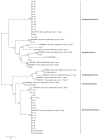Genetic Evaluation of Bovine Papillomavirus Types Associated with Teat Papillomatosis in Polish Dairy Cattle with the Report of a New Putative Type
- PMID: 38003743
- PMCID: PMC10674157
- DOI: 10.3390/pathogens12111278
Genetic Evaluation of Bovine Papillomavirus Types Associated with Teat Papillomatosis in Polish Dairy Cattle with the Report of a New Putative Type
Abstract
Teat papillomatosis is reported to be one of the factors causing mastitis and milk losses in dairy cattle. Little is known about bovine papillomavirus (BPV) circulation in the European cattle population, and no reports can yet be found about its prevalence in Polish herds. In this study, 177 BPV-like lesions were collected from teats of 109 slaughtered cows. BPV was identified in 39 of the examined animals, using PCR amplification and Sanger dideoxy sequencing. In total, 10 BPV types were isolated, among which the most common were infections caused by types 8 and 7. Macroscopically, "rice-grain" type lesions dominated (76%) and were mainly found on one teat (57.4%). The diversity of BPV types causing teat papillomatosis in Polish cows seems to be large, with nine already known types isolated and a new putative type found. The spread of new types among the worldwide cattle population can be seen for the first time, as type 25 and so called isolates BPV42 and BPV43 were found in the European cattle population.
Keywords: Poland; bovine papillomavirus; cattle; papillomatosis; teat.
Conflict of interest statement
The authors declare no conflict of interest.
Figures





Similar articles
-
Genetic diversity of bovine papillomavirus types, including two putative new types, in teat warts from dairy cattle herds.Arch Virol. 2016 Jun;161(6):1569-77. doi: 10.1007/s00705-016-2820-0. Epub 2016 Mar 21. Arch Virol. 2016. PMID: 26997614
-
Molecular and pathological characterization of teat papillomatosis in dairy cows in southern Brazil.Braz J Microbiol. 2020 Mar;51(1):369-375. doi: 10.1007/s42770-019-00175-2. Epub 2019 Oct 23. Braz J Microbiol. 2020. PMID: 31642003 Free PMC article.
-
Phylogenetic analysis and searching bovine papillomaviruses in teat papillomatosis cases in cattle by performing histopathology, immunohistochemistry, and transmission electron microscopy.Microb Pathog. 2022 Sep;170:105713. doi: 10.1016/j.micpath.2022.105713. Epub 2022 Aug 14. Microb Pathog. 2022. PMID: 35977649
-
Animal models of papillomavirus pathogenesis.Virus Res. 2002 Nov;89(2):249-61. doi: 10.1016/s0168-1702(02)00193-4. Virus Res. 2002. PMID: 12445664 Review.
-
Papillomatosis in buffaloes: a less-known disease.Transbound Emerg Dis. 2011 Aug;58(4):327-32. doi: 10.1111/j.1865-1682.2011.01211.x. Epub 2011 Mar 16. Transbound Emerg Dis. 2011. PMID: 21435195 Review.
Cited by
-
Molecular and Histological Identification of Bovine Papillomavirus 1, 2 and a Novel Genotype in Cutaneous Papillomas of Dairy Cattle in Taiwan.Transbound Emerg Dis. 2025 Jun 25;2025:5586786. doi: 10.1155/tbed/5586786. eCollection 2025. Transbound Emerg Dis. 2025. PMID: 40607128 Free PMC article.
-
Exploring the therapeutic potential of Quercus ilex acorn extract in papillomavirus-induced lesions.Vet World. 2024 Nov;17(11):2644-2658. doi: 10.14202/vetworld.2024.2644-2658. Epub 2024 Nov 28. Vet World. 2024. PMID: 39829663 Free PMC article.
-
Bovine Papillomavirus Genotypic Diversity and a Putative Novel Viral Type in Ecuador.Vet Sci. 2025 Jul 17;12(7):672. doi: 10.3390/vetsci12070672. Vet Sci. 2025. PMID: 40711332 Free PMC article.
References
-
- Campo M.S. Bovine papillomavirus: Old system, new lessons? In: Campo M.S., editor. Papillomavirus Biology: From Natural History to Vaccine and Beyond. 1st ed. Caister Academic Press; Poole, UK: 2006. pp. 1–31.
-
- PaVE Papillomavirus Episteme. [(accessed on 13 April 2023)]; Available online: https://pave.niaid.nih.gov/
-
- Sauthier J.T., Daudt C., da Silva F.R.C., Alves C.D.B.T., Mayer F.Q., Bianchi R.M., Driemeier D., Streit R.S.A., Staats C.C., Canal C.W., et al. The genetic diversity of “papillomavirome” in bovine teat papilloma lesions. Anim. Microbiome. 2021;1:51. doi: 10.1186/s42523-021-00114-3. - DOI - PMC - PubMed
LinkOut - more resources
Full Text Sources

